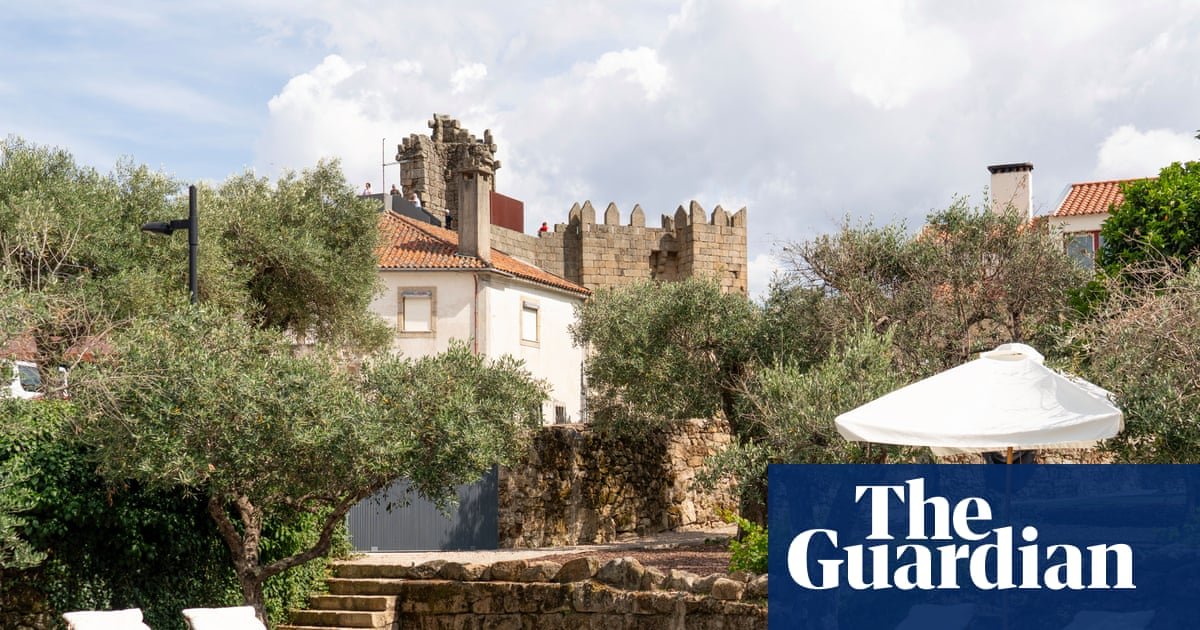Solo Travellers
In Her New Travel Series, Tracee Ellis Ross Overpacks Unapologetically

We may be living in an era of carry-on-only travel as the cultural norm, but Tracee Ellis Ross has never been one to follow a trend. The actress, Pattern Beauty founder, and host of the new series Solo Traveling with Tracee Ellis Ross overpacks with gusto. You could say it’s in her DNA. “I mean, come on. We all know who my mom is. What do you think? She was only doing a carry-on? Get out of here!” the daughter of Diana Ross says over Zoom during a recent interview (wearing her signature red lips, of course).
In Solo Traveling, which premieres on The Roku Channel July 25, the star offers a deeper look into her jet-setting lifestyle. Each episode opens with a sprawl of clothing: wide-brimmed hats, racks of skirts and printed jackets, rows of perfectly folded tops, while Ross shows off her meticulous packing process for each trip. (“There are way more outfits than I’ll be able to wear here,” she says in one scene, ruminating over what to leave behind. And anyone familiar with Ross’s fashion game knows she makes no bones about pushing the boundaries of style.)
Across three 30-minute-long episodes, the actress traverses the red-walled medina of Marrakesh, a rainy Cancún, and sunny Marbella, Spain. Of course, between the lavish resorts and hotels, there’s a healthy dose of glam. But the show also comes with a sense of vulnerability in her confessional-style musings on being “a single Black woman,” she says. “Not having long relationships, not having children, has allowed me to explore things of my own humanity,” Ross tells viewers in another scene, clad in a terrycloth robe, preparing for a solo night out. “It has deposited me here, at 52, in an experience filled with joy, loneliness, grief, delight—all of it.”
A still from Solo Traveling.
These kinds of reflective moments, often filmed on her iPhone, set Solo Traveling apart from prescriptive travel shows. Viewers, beware: if you’re searching for a series where the lead climbs Mount Everest and samples fermented mystery meats for kicks, it’s not here.
“When I was on Black-ish, [creator] Kenya Barris used to say, ‘Would a human do that?’” Ross adds. “In comedy, things are sometimes embellished for the sake of a laugh, in a way that you lose sight of the grounding humanness. But travel offers a heightened life experience. The joyous things might be more acute, and so might the hard things.”
The stunning locations featured in the series are eye candy, no doubt. But the draw is the peek into the interior life of a self-possessed woman who loves a good meal, a good buy, and talking endlessly with strangers. When it comes to travel necessities, Ross emphasizes that being human is at the fore—keep yourself open to new experiences, people, and places. And when in doubt, reach for the compression socks. Below, Ross shares her travel necessities.
The Basics:
“I love compression socks: thigh-high, toes out!” she says. “I buy them on Amazon. I also still wear KN95 masks; I don’t go into airports and airplane bathrooms without one. And hand sanitizer and wipes—I was a wiper-downer before COVID, and I maintained that. I use Sono Wipes to clean off bedside tables, bathrooms, my airplane seat, all of it.”
Clean Air:
“I wear a personal air purifier called an AirTamer around my neck, particularly in the airport and in shared cars where you don’t know who’s been in it before you.”
Some Comfort:
“I never forget to pack a Save My Face pillow—it’s the same pillow that I sleep with at home. I have two, one is for the house, and one is for travel. I buy their pillowcase, and then there’s a company that makes organic pillow stuffing, and you can buy bags of it. So I make my pillows to the exact density that I like.”
First Aid:
“I always bring an extensive medical kit on my travels. It has everything from Neosporin to alcohol pads and anti-nausea medication. The truth is, I’ve never had to go into that medical kit until my trip [to Spain], where I got food poisoning. I had charcoal, I had Peptol Bismol, I had all of that stuff. I even had electrolytes.”
This interview has been condensed and edited for clarity.
Solo Travellers
How to holiday safely this summer under the Mediterranean sun

In recent years, many of the Mediterranean’s iconically sunny destinations like Italy, Greece, France and Spain have become increasingly besieged by devastating heatwaves, leading unsuspecting tourists to come up with creative solutions to keep cool.
“Our hotel had AC technically, but it groaned like a dying fan and gave up by mid-afternoon,” said Fowkes. “The tap water came out warm. There were no blackout curtains. I tried sleeping with a wet towel on my chest and a bottle of frozen water under my knees and still woke up dizzy. At one point, I moved my pillow to the stairwell and lay on the tiles like a Victorian fainting lady because that was the only surface remotely cool.”
Solo Travellers
American, United Airlines Overcharging Solo Travelers; Delta, Southwest Remain Affordable: Here’s What You Need to Know Now – Travel And Tour World
Solo Travellers
Explore Portugal’s historic hilltop hamlets in a free electric hire car | Portugal holidays

Twisting along roads flanked by cherry trees, granite boulders, vines and wildflower-flecked pastures, I wind down the windows and breathe in the pure air of Portugal’s remote, historic Beira Interior region. The motor is silent, the playlist is birdsong and occasional bleating sheep; all is serene. “This is easier,” I say to myself with a smile, recalling my previous attempt to visit the Aldeias Históricas – a dozen historic hamlets bound by a 1995 conservation project – using woeful public transport. Revisiting this unspoilt pocket of Portugal, 155 miles (250km) north-east of Lisbon, near the border with Spain, is going to be effortless in an EV. And, best of all, the transport doesn’t cost me a penny.
An hour before, I arrived in Castelo Novo, a four-hour train ride from the capital, and currently the sole hub of the Aldeias Históricas’s Sustainable Urban Mobility Scheme. It was launched in 2022 to address local transport issues by providing five free-to-hire electric vehicles, alongside other community-supporting projects. It sounded too good to be true, but I booked the maximum three-day rental – enough time to see at least nine of the villages. I was informed that if I arrived by train, someone would meet me at the station.
Sure enough, Duarte Rodrigues welcomes me like an old friend. “The project’s main focus is tourism to the historic villages, but some of the cars are used for the community, to take elderly people to the market or distribute meals,” he says on the gorgeous drive to the medieval hamlet of Castelo Novo, 650 metres up the slopes of the Serra da Gardunha. Take-up was nearly equal between tourists and residents, he adds.
A few minutes later, outside the romanesque town hall, Duarte hands me the keys to my Megane E-Tech with a wave. It’s worth staying for a night at Pedra Nova, a gorgeously renovated boutique B&B, but it needs to be booked well in advance and I am keen to make the most of my time in the EV. Having decided to skip popular Piódão and Monsanto – now a House of the Dragon jet-setting destination – my first stop is Belmonte. Like all 12 aldeias, this hazy hilltop town played a pivotal role in Portugal’s identity. A Brazilian flag flutters behind a statue of local legend Pedro Álvares Cabral, the first European to “discover” Brazil. I stroll through the old Jewish Quarter’s single-storey granite houses to Bet Eliahu synagogue, built 500 years after King Manuel I’s 1496 decree expelling Jews from the kingdom.
Continuing to 12th-century Linhares da Beira, I wander the leafy slopes of the Serra da Estrela – mainland Portugal’s highest range. Similar to much-loved Monsanto, the hamlet lies between and atop giant granite boulders. From the largest rocky outcrop, where the castle’s crenellated walls rise, the Mondego valley’s panorama is endless. Other than an airborne paraglider and a man hawking hand-carved magnets in the car park, there’s not a soul in sight.
I walk a stretch of slabbed Roman road that once linked Mérida in Spain to Braga, north of Porto, and remember why I adore these villages. History is bite-size, hushed and unhurried, the antithesis of my home in the Algarve. After a brief drive, I park up and plug in outside the medieval defences of the most populated aldeia.
Founded in the ninth century, handsome Trancoso hides behind hefty, turret-topped walls that have witnessed royal nuptials and numerous skirmishes. Today, walking beneath weathered porticos and streets lined with hydrangeas, it feels like the calmest place in the world. As does Solar Sampaio e Melo, a palatial 17th-century guesthouse – repurchased by a descendant of the original owners in 2011 – with an honesty bar and a pool shaded by turrets.
Following a late breakfast of sardinhas doces, Troncoso’s sardine-shaped, almond-stuffed sweets, I make for Marialva. The satnav states 30 minutes, but with back-road detours to gawp at giant granite mounds around Moreira de Rei, I reach the massif-mounted castle well after lunch. Occupied by the Aravos, a Lusitanian tribe, then the Romans and Moors, this was a crucial site for the advance of the Christian Reconquista.
An old chap in a checkered shirt sits hammering almonds from their shells outside his home. I buy a bulging bag for €7 and gobble a handful inside the semi-ruined citadel, where Bonelli’s eagles soar and cacti reclaim the stone. The flavour transports me to my Algarvian childhood holidays, when I’d hide from the sun (and my parents) under almond trees. For a second, it feels like Portugal hasn’t changed in 30 years. Perhaps here, far from the coast, little has.
The journey to Castelo Rodrigo is filled with awe, particularly around the craggy valley sliced by the Côa river. Just upstream is a unique collection of rock art etchings from three eras – prehistory, protohistory and history – and Faia Brava, Portugal’s first private nature reserve, co-founded by biologist Ana Berliner, her husband and others. In 2004, the couple renovated Casa da Cisterna into a boutique guesthouse, and on its wisteria-draped terrace, Ana welcomes me with sugared almonds and fresh juice. I enquire about Faia Brava (Ana guides guests on excursions to the reserve and the prehistoric rock art) and whether they’re concerned about tourism growing.
“These small villages benefit a lot [from tourism] because there aren’t many people living here or many opportunities, so people are moving to the big cities,” she tells me. “If you retain your people, and your young people spend those days living here, it’s very good.”
As I poke around the castle ruins, I mull over how the Portuguese writer José Saramago described Castelo Rodrigo in Journey to Portugal (1981): “desolation, infinite sadness” and “abandoned by those who once lived here”. I’m reassured that Ana is right. Lisbon’s tourism boom has created Europe’s least affordable city for locals. Yet, in these hinterlands, the right tourism approach could help preserve local customs.
Unlike most of the aldeias, Castelo Rodrigo was founded by the Kingdom of León. It became Portuguese when the 1297 treaty of Alcanizes defined one of Europe’s oldest frontiers. Reminders of Spain linger, such as the Ávila-style semicircular turrets and ruined Cristóvão de Moura palace, constructed under the Habsburg Spanish kings. Portuguese locals later torched it.
With no charging station in Castelo Rodrigo (work is under way to expand the project to other villages, including the installation of chargers and the opening of new bases with additional cars in 2026), I drive to Figueira de Castelo Rodrigo, the modern town below. At Taverna da Matilde flaming chouriço scents the dining room, and the pork loin – bisaro, an indigenous part-pig, part‑boar – is perfect. I sleep like a prince at Casa da Cisterna.
Breakfast is a casual, communal affair of buttery Seia mountain cheese and pão com chouriço, followed by a quick stop at Castelo Rodrigo’s wine cooperative to collect a case of robust Touriga Nacional (tours and tastings €18pp). In Almeida, a star-shaped military town, I roam the grassy ramparts before continuing south. Swallows soon replace eagles, and granite fades into gentle farmland.
I breathe in the silence, standing by Castelo Mendo’s twin-turreted gate. It feels like the world has stopped. I tiptoe across the ruined castle keep and am transfixed by the endless panorama of olive groves, cherry trees and occasional shepherd’s huts.
In search of coffee, I step into a dimly lit stone room below a sign that reads D Sancho. Inside is an old-world retail marvel. Photos of popes, boxes of wine, retired horseshoes, mounds of old coins and “mystery boxes” that I’m tempted to spend a tenner on. A hunched woman with a smile gifts me a shot of ginjinha, the local cherry liquor, and signals me to sit with her on the bench outside. We don’t speak, yet I somehow feel a connection to her land. I buy a bottle in the hope of taking that feeling home.
My final stop, Sortelha, comes with high expectations – Saramago promised a perfectly preserved medieval town. Hulking walls cradle a 16th-century cluster of stone houses dominated by a castle that crowns an outcrop. Almost on cue, fog and showers shroud it all in mystery. I retreat to O Foral, where plates of bacalhau (salted cod) are bathed in pistachio-hued local olive oil.
Parking back in Castelo Novo with a panic-inducing 7% charge showing on the dash, I am grateful to return the keys, and use the time before my lift to the station to survey the Knights Templar’s former domain from the 12th-century castle.
Stopping outside the red door where Saramago reportedly once stayed, I ponder how he would describe these villages 44 years later. Hopefully, he’d recount that, for the traveller, timeless magic remains, but those returning and reviving have vanquished any melancholy.
Complimentary EV rentals of one to three days can be booked online at plataformaaldeiashistoricas.com; reservations open about 75 days in advance. For details of the 12 Aldeias Históricas, visit aldeiashistoricasdeportugal.com
-

 Brand Stories5 days ago
Brand Stories5 days agoBloom Hotels: A Modern Vision of Hospitality Redefining Travel
-

 Brand Stories14 hours ago
Brand Stories14 hours agoCheQin.ai sets a new standard for hotel booking with its AI capabilities: empowering travellers to bargain, choose the best, and book with clarity.
-

 Destinations & Things To Do6 days ago
Destinations & Things To Do6 days agoUntouched Destinations: Stunning Hidden Gems You Must Visit
-

 AI in Travel6 days ago
AI in Travel6 days agoAI Travel Revolution: Must-Have Guide to the Best Experience
-

 Brand Stories3 weeks ago
Brand Stories3 weeks agoVoice AI Startup ElevenLabs Plans to Add Hubs Around the World
-

 Brand Stories2 weeks ago
Brand Stories2 weeks agoHow Elon Musk’s rogue Grok chatbot became a cautionary AI tale
-

 Asia Travel Pulse3 weeks ago
Asia Travel Pulse3 weeks agoLooking For Adventure In Asia? Here Are 7 Epic Destinations You Need To Experience At Least Once – Zee News
-

 Destinations & Things To Do11 hours ago
Destinations & Things To Do11 hours agoThis Hidden Beach in India Glows at Night-But Only in One Secret Season
-

 AI in Travel3 weeks ago
AI in Travel3 weeks ago‘Will AI take my job?’ A trip to a Beijing fortune-telling bar to see what lies ahead | China
-

 Brand Stories3 weeks ago
Brand Stories3 weeks agoChatGPT — the last of the great romantics










You must be logged in to post a comment Login